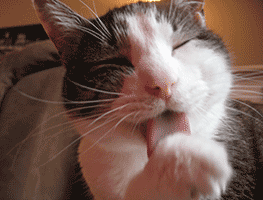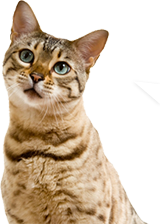Overstimulation to Petting
Overstimulation to petting occurs when a cat finds petting or handling unpleasant. It is a normal response if a cat is experiencing discomfort. How much petting a cat finds enjoyable depends on the cat; not every cat becomes overstimulated with petting.
While some cats enjoy endless petting, others begin to find petting uncomfortable. Cats may hiss, growl, swat, or even bite as a way of letting us know they are not enjoying the interaction. Petting may physically cause a cat pain and may frustrate a cat if they lack control of the situation. Fortunately, cats typically give us subtle warning signs with their body language that the petting is unwanted. The number and intensity of warning signals vary, but when those warning signs are neglected or ignored, it might result in an aggressive reaction.
Know the warning signs
Cats rarely just turn and bite. Observation of changes in cat body language can help us predict when a cat is becoming overwhelmed:
- Ears may go back or flick back and forth
- Tail may start to swish, thump, or twitch
- Pupils of the eyes may dilate
- Muscles may become tense
- Claws may become exposed
- Cats may turn their head quickly toward your hand, often called a ‘head flip’
- Cat may hiss, growl, or attempt to bite
If you see any of these warning signs, STOP petting and do not attempt to interact. Allow the cat to decompress. If the cat does not choose to leave the interaction, you can toss a treat or toy off your lap to redirect. DO NOT attempt to pick up an overstimulated cat.
Time your petting
Once you are aware of the warning signs, you can start to time how long your cat likes to be petted. If the warning signs start about 2 minutes after starting to pet the cat, then never pet the cat for more than a minute and a half. (Always continue to watch for warning signs.)
Change how you pet your cat
Some cats prefer to be scratched under the chin or between the ears instead of receiving long, whole-body strokes. Try using one finger to pet gently solely on the face and cheeks. Let them rub on you. Often cats are happy just to rub on their person and don’t desire extended handling at all.
Daily playtime is important
Sometimes overstimulation is due to frustration from boredom. Make sure that your cat gets a good play session daily. Keeping your cat active and engaged is a good way to reduce frustration. Please see the “Enriching Your Cat’s Life” handout for ideas on how to keep your cat physically and mentally stimulated.
Modify behavior with high-value treats
Use positive reinforcement techniques to help connect petting with something your cat enjoys. After each stroke of petting, give your cat a treat he/she enjoys (small bit of canned food, cooked chicken, tuna, soft packaged treats, etc.). These should be short sessions and can be done multiple times a day. Stop if your cat shows any warning signs. In time, your cat may start to relate petting to something very enjoyable (a food treat).
Your cat may never want petting
Each cat is unique. Some cats enjoy human contact and love to be petted and held. Others may enjoy human companionship, but not necessarily human-initiated contact. Understand that while you can make positive associations with petting, some cats may never be able to handle petting and you should interact with them in whichever way they find positive and reinforcing.
If you have additional questions, contact the Wisconsin Humane Society behavior department at asktheexpert@wihumane.org or 414-431-6173.

